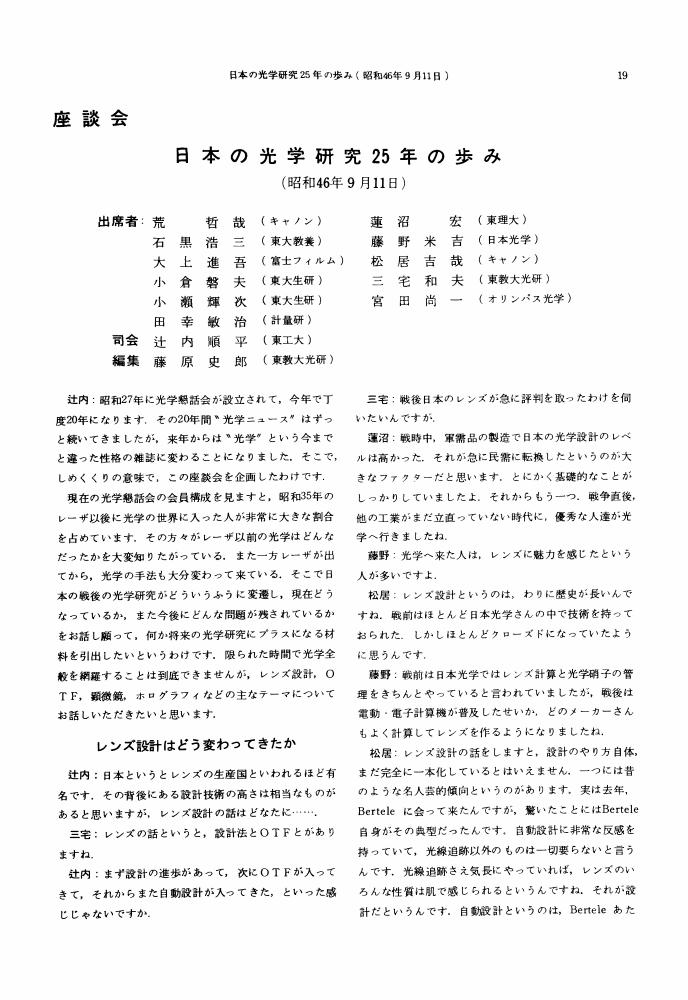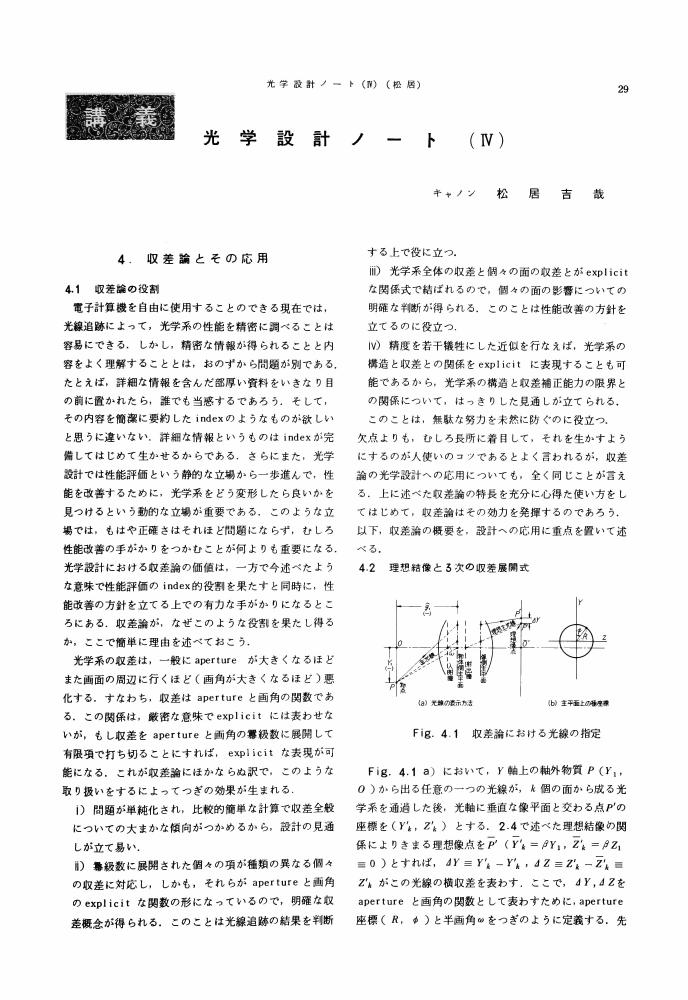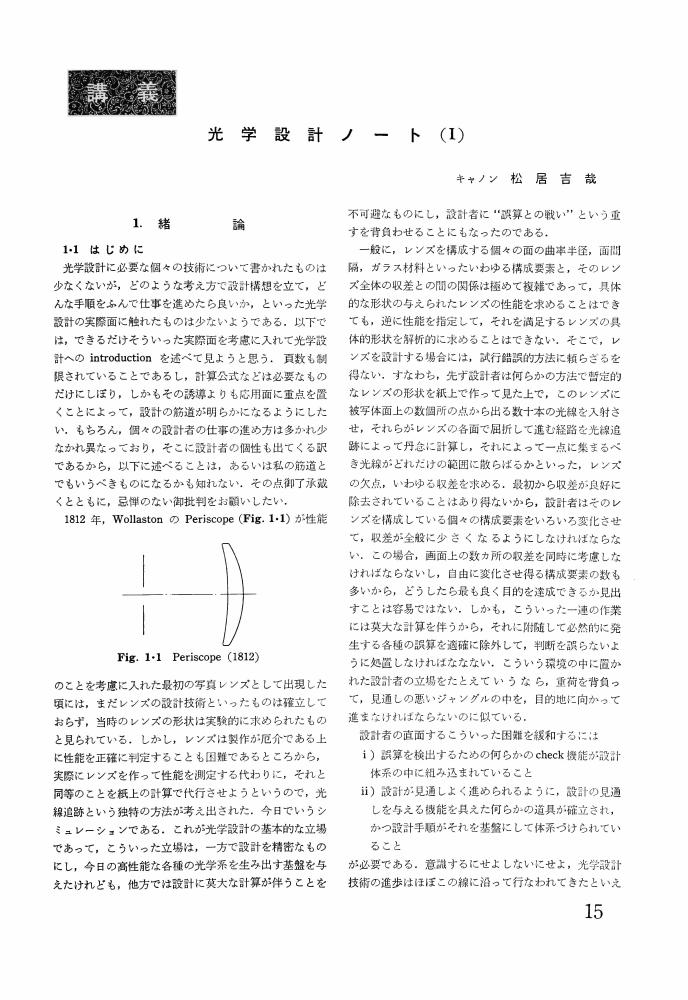3 0 0 0 OA 5次収差論の実用化 (第4報) II. 共軸屈折球面系への適用 (2)
- 著者
- 松居 吉哉
- 出版者
- 公益社団法人 応用物理学会
- 雑誌
- 応用物理 (ISSN:03698009)
- 巻号頁・発行日
- vol.29, no.4, pp.256-267, 1960-04-10 (Released:2009-02-20)
- 参考文献数
- 1
In the preceding paper, two sets of unique expressions of the intrinsic aberration coefficients are shown. From either of these, computing formulas can be developed by introducing suitable dependent variables. Among the dependent variables, the most favourable ones to arrange the formulas are J and its reciprocal _??_. Here J=_??_/hQ and _??_=hQ/≡1/J. From the expressions of the intrinsic coefficients by h, h and Q, the first system of computing formulas is developed (formulas from (II•5•2) to (II•5•4c)). From the expressions by h, h and Q, the second system of computing formulas is developed (formulas from (II•5•5) to (II•5•7c)). By using either of the computing systems, the values of the aberration coefficients can be obtained for one surface of the optical system. The aberration coefficients of the total system are obtained by addition of these values for all surfaces. Both of these computing systems should give the same values of the aberration coefficients for the same surface. In the case of the first computing system, the spherical aberration coefficients are computed at the outset, then other coefficients are computed one by one with the aid of the factor J. On the other hand, in the case of the second computing system, the distortion coefficients are computed at the outset, then other coefficients are computed with the aid of the factor _??_. In the case of the surface, at which hQ tends to zero, the results obtained by the first computing system may be accompanied with serious error, and consequently, the second computing system is preferred. But in the case of the surface, at which hQ tends to zero, the first computing system is preferred. With a digital computor, such discrimination can be performed by proper programming, and the results can be automatically guarded against undesirable errors. As numerical examples, typical Gauss-type and Sonnar-type objectives are cited. For these examples, numerical values of the 3rd and 5th order aberration coefficients, the aberration figures computed from these values and the comparison with the actual values are shown.
3 0 0 0 OA 5次収差論の実用化 I. 一般論 (2)
- 著者
- 松居 吉哉
- 出版者
- 公益社団法人 応用物理学会
- 雑誌
- 応用物理 (ISSN:03698009)
- 巻号頁・発行日
- vol.28, no.12, pp.687-697, 1959-12-10 (Released:2009-02-09)
In the preceding paper, starting from the Herzberger-Focke's fifth order aberration theory, the author has defined the new practical aberration coefficients, which correspond to the Berek's coefficients in the region of the third order. In this paper, the various formulas of the aberration coefficients are considered. The contents are: Relation between the aberration coefficients of image and those of pupil; shifting of pupil and object; curvatures of object, image and pupil surfaces; relations between the intrinsic and the total aberration coefficients; and the aberration coefficients based upon the exit pupil coordinates. Most of the formulas are derived from the Herzberger's theory, but some of them are supplied by the author. Every transformation formula may be applied to both the intrinsic and the total aberration coefficients of any rotationally symmetrical system.
3 0 0 0 OA 5次収差論の実用化 (第3報) II. 共軸屈折球面系への適用 (1)
- 著者
- 松居 吉哉
- 出版者
- 公益社団法人 応用物理学会
- 雑誌
- 応用物理 (ISSN:03698009)
- 巻号頁・発行日
- vol.29, no.3, pp.184-194, 1960-03-10 (Released:2009-04-02)
- 参考文献数
- 6
In the previous papers, new practical aberration coefficients are defined and various transformation formulas based on the general properties of coaxial optical system are considered. For actual calculations, however, formulas to compute the aberration coefficients by using constructional data of the optical system are needed. The object of this article is to develop computing formulas of the simplest and most reasonable form. For the present, the optical system is assumed to be composed merely of the spherical refractive surfaces.The relations between the intrinsic and the total aberration coefficients are already explained in the previous paper (I. General Theory, §11). Thus, the problem in hand is to derive the expressions of the intrinsic aberration coefficients. These expressions can be derived by starting from the special case in which the coefficients become zero and by applying the various transformation formulas (given in the previous paper) as was worked out by J. Focke (see reference 4). These can also be derived from the Focke's expressions by applying the two transformations as shown in the previous paper (I. General Theory, §4 and §5).In either case, the greatest difficulty is in arranging these expressions to develop computing formulas of the simplest form. One way to avoid confusion in the process is to express the intrinsic coefficients by independent variables and then develop the simplest forms by introducing the suitable dependent variables. Among the variables that have influence upon the intrinsic coefficients, three variables besides the constructional data are independent. Many sets of the three independent variables can be considered, but the most reasonable sets to express the intrinsic coefficients are the following two, viz.i) h, h, Q;ii) h, h, Q;here, h and h are the incident heights of paraxially traced object and pupil rays; Q and Q are the Abbe's invariants for these rays respectively. By using either set, the intrinsic coefficients can be expressed “uniquely”. Thus, two sets of “unique” expressions of the intrinsic aberration coefficients are derived. These expreseions may be regarded as the bases to develop the computing formulas.
3 0 0 0 OA 5次収差論の実用化 I. 一般論 (1)
- 著者
- 松居 吉哉
- 出版者
- 公益社団法人 応用物理学会
- 雑誌
- 応用物理 (ISSN:03698009)
- 巻号頁・発行日
- vol.28, no.11, pp.642-650, 1959-11-10 (Released:2009-02-09)
- 参考文献数
- 8
The aberration theory is important as the basis of optical design. From this standpoint, however. the expressions should be arranged more or less different from those which are arranged with the theoretical interest alone. Recent advance in optical systems has made third order theories too insufficient and fifth order theories have been developed by many authors. But, the practical expressions seem to be still required from the standpoint of optical design. The author tries to establish the practical expressions, starting from the Herzberger-Focke's fifth order theory. Herzberger-Focke's theory is noticeable for its clear physical meaning. But, it has a few defects for practical purposes, that is: i) it does not use the “reduced coordinates”, and then, it is difficult to apply it to the optical systems, comprising many refracitive surfaces. ii) it uses the “exit-pupil coordinates” instead of the “entrance-pupil coordinates” and also does not usually fit to the practical work. In this paper, the author applies the two transformations to the Herzberger's expressions, that is, from the “Herzberger coordinates” to the “reduced coordinates” and, from the “exit-pupil co-ordinates” tothe “entrance-pupil coordinates”. Upon this, the author defines the new symbols of the aberration coefficients, which correspond to the Berek's symbols.
2 0 0 0 OA 日本の光学研究25年の歩み
1 0 0 0 OA 光学設計ノート (IV)
- 著者
- 松居 吉哉
- 出版者
- 公益社団法人 応用物理学会分科会 日本光学会
- 雑誌
- 光学ニュース (ISSN:18839665)
- 巻号頁・発行日
- vol.1969, no.104, pp.29-39, 1969-08-10 (Released:2010-11-17)
- 参考文献数
- 4
1 0 0 0 OA 収差論・ズームレンズ設計理論の発展
- 著者
- 松居 吉哉
- 出版者
- 公益社団法人 応用物理学会
- 雑誌
- 応用物理 (ISSN:03698009)
- 巻号頁・発行日
- vol.51, no.5, pp.513-516, 1982-05-10 (Released:2009-02-09)
- 参考文献数
- 30
第2次大戦後,日本の光学レンズは目覚ましい発展を遂げるに至ったが,それを支えた技術的な基盤の一つに光学系のsynthesisに関連する理論がある.その中でも重要な位置を占めるのが収差論とズームレンズの設計理論である.これらが実際のレンズ設計で果たす役割と,日本における研究の発展について概観する.
1 0 0 0 OA 光学設計ノート (I)
- 著者
- 松居 吉哉
- 出版者
- 公益社団法人 応用物理学会分科会 日本光学会
- 雑誌
- 光学ニュース (ISSN:18839665)
- 巻号頁・発行日
- vol.1969, no.101, pp.15-24, 1969-02-10 (Released:2010-11-17)
- 参考文献数
- 6
- 著者
- 松居 吉哉
- 出版者
- 応用物理学会
- 雑誌
- 応用物理 (ISSN:03698009)
- 巻号頁・発行日
- vol.51, no.5, pp.p513-516, 1982-05
1 0 0 0 レンズ設計における収差論の役割と正規化問題
- 著者
- 松居 吉哉
- 出版者
- 応用物理学会分科会日本光学会
- 雑誌
- 光学 (ISSN:03896625)
- 巻号頁・発行日
- vol.13, no.6, pp.p482-489, 1984-12


